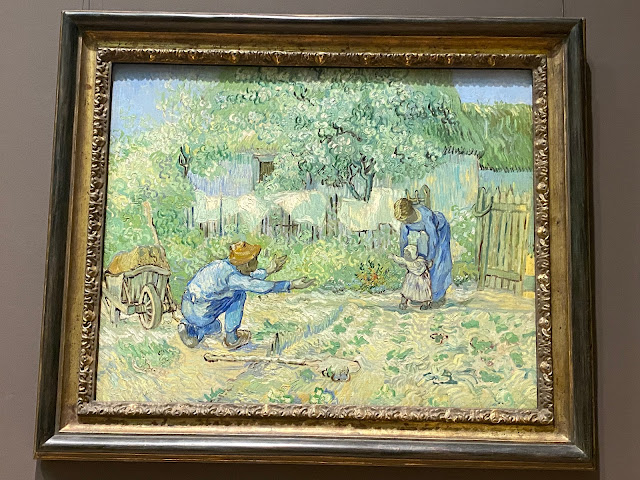Day 328 - The unexpected
January 5, 2023
Gallery 825, which focuses on the Post-Impressionists, contains both familiar works and surprises. The former include van Gogh's painting of a bowl of irises and Gauguin's "La Orana Maria." But three works that especially draw my attention are unfamiliar to me and challenge my thinking, albeit in very different ways.
The first is a painting van Gogh completed in 1890, while he was living in the asylum to which he had committed himself. The placard notes that van Gogh greatly admired Millet and made copies of his works. This one, entitled "First Steps, after Millet" and measuring approximately 36 inches wide and 26 inches high, is instantly recognizable as a van Gogh on the basis of its style (the short brush strokes, the squiggly lines depicting vegetation), but the scene, showing a toddler guided by its mother and advancing, presumably shakily, toward its kneeling father's outstretched arms, is tender, loving, and absolutely antithetical to the stereotypes I have of van Gogh's images of peasants. It's probably silly - although perhaps inevitable - to try to read the painting in biographical terms, but I can imagine that the subject provided solace to van Gogh at an especially troubled point in his life.
The second work, also by van Gogh and called "The Flowering Orchard," was painted two years earlier. Relatively small in size (about 20 inches high and 13 inches wide), it strikes me as filled with joy.The soft palette evokes the freshness of spring, with light greens used to depict the newly flowering leaves of the trees and the lush grass, shot through with wildflowers, that surrounds them. According to the description, van Gogh wrote to his brother Theo, "the trees are in blossom and I would like to do a Provencal orchard of tremendous gaiety." He succeeded. Again, this painting contravenes the stereotype of van Gogh as a tortured artist whose works reflect his agitated state of mind.
Finally, a 1908-9 painting by Henri Rousseau (le Douanier) and entitled "The Banks of the Biere near Bicetre," surprises me because I thought I knew a bit about Paris. But I learn that the a century or so ago, the Biere River, of which I'd never previously heard, flowed through a working-class community on the southern edge of Paris; now it is buried underground. The painting, which measures about 26 inches high and 20 inches wide, shows a walkway along the river. It's painted in Rousseau's unmistakable "primitive" style, and it reminds me works by American primitives (well, okay- Grandma Moses), with its hyperrealistic elements. But in Rousseau, the realistic is suffused with the surreal; the trees that line the allee would seem to be more at home in the jungle.






Comments
Post a Comment